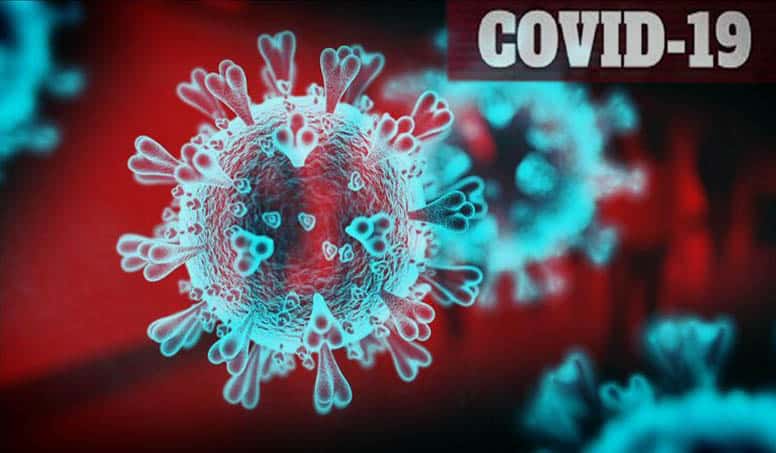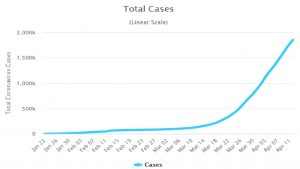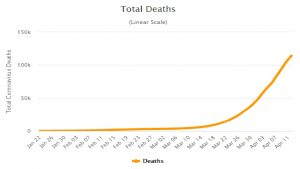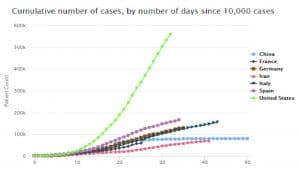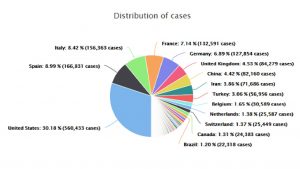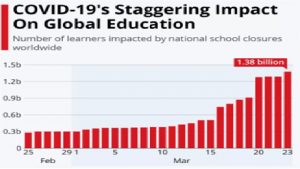Table of Contents
ToggleIntroduction
One of the foremost and first health crises has been reported in 2019 as COVID – 19 pandemic. The COVID – 19 pandemic has affected global education facilities, its students and learning curriculums. This pandemic has forced the closure of all schools, colleges, and universities worldwide. Approximately 99.4 percent of the global student population that is 1.716 billion students has been impacted due to this nationwide closure for this particular COVID – 19 pandemic. This nationwide closer has not only impacted on the students learning but also impacted on their family’s productivity. Therefore, as a potential consequence, the whole socio-economic condition of the world wide nation is facing a huge crisis. Students and their learning curriculum move to the online learning facilities from real-life learning systems. This particular paper has a clear focus on the analysis and synthesis of the impacts of COVID – 19 on the global education system and its students. Furthermore, this paper also provides some possible solutions and recommendations for the consequences of this crucial epidemic situation.
A brief discussion on COVID -19 pandemic
COVID – 19 pandemics is caused by a large group of viruses called coronavirus. This group of viruses is made of genetic material in the core and especially surrounded by an envelope along with several protein spikes. These spikes look like crowns and this originates from its name coronavirus. There are three different types of coronaviruses identified previously and one of them caused the COVID – 19 pandemics. This group of coronaviruses causes several diseases such as gastrointestinal diseases, respiratory disease and pneumonia (Guarner, 2020). The first identified coronavirus is known as SARS – COV, the second identified virus known as MERS – COV and the third identified virus is known as COVID – 19. The first and second type of coronaviruses has severe disease compared to the 2019 coronavirus (Goh & Sandars, 2020). This disease was first reported in China Wuhan city and then spread to the rest of the world. The transmission of this virus is generally determined as the droplets caused by the coughs and sneezes of an infected person to another non-infected person. It is also determined that the virus can land on the different surfaces and touching those surfaces aliases transmit this virus to humans (Wu & McGoogan, 2020). However, it is not determined yet how long the viruses can survive in a particular surface in order to transmit to a human. It has been recognized and analyzed by researchers that the rate of human to human transmission has an exponential growth in terms of spreading to the humane society. The number of cases was increasing rapidly that the health care system was overwhelmed by the infected peoples. After these kinds of consequences, the world health organization announced this virus as a pandemic to society (World Health Organization, 2020). The number of cases was increasing exponentially that chain had reached from 42 identified cases to 76,936 cases in just one month. It was announced by the chain on January 11 of its first death due to coronavirus cases and on January 27th, China reported 170 deaths among 7,711 infected cases [refer to the appendix 2]. Therefore, the treatment of each person was difficult for the existing health care system. Due to the overwhelming health care system and uncontrolled increase in the infection or transmission rate the novel coronavirus spread to the rest of the world in an exponential increasing growth rate. The major solution is a vaccine. However, no vaccine developed yet to treat this virus disease and research is going on to develop a proper vaccine to treat this virus. The researchers also find out a temporary solution to this problem that is to decrease the infection rate by maintaining the physical distance between humans, as this virus spreads rapidly from person to person. Researchers also called this solution as “flatten the curve” which means to flatten the exponential growth curve of infection rate. Therefore, this worldwide increasing amount of infected cases leads to implement the possible solution that is social distancing or physical distancing. Majority of the worldwide nations have announced to close or lock down all the public gathering activities such as school, colleges, universities, offices, workplaces, public transport, airlines, sports and other types of human gatherings. People are advised strictly to stay at their home as a solution to virus transmission (McKibbin & Fernando, 2020).
How it emerged and its potential consequences
China has reported a cluster of pneumonia cases in December 2019. The researchers and doctors identified these symptoms that were caused by a previously unknown virus. Therefore, this virus is also named as the 2019 Novel Coronavirus. It was reported in china that many people were getting sick due to Pneumonia disease, high fever and other severe symptoms. The clear cause of this type of symptoms was unknown to the medical specialist. It was initially recognized that the number of cases was directly linked to the west seafood market in Wuhan China (Ahmed, Allaf & Elghazaly, 2020). Researchers had initially argued that the 2019 novel coronavirus comes from different wild animal species that were sold in the Wuhan wet seafood market. This seafood market also sells all the different wild animals including snakes, bats, penguin and other wild animal species. The researchers have formulated an initial hypothesis that this coronavirus evolved in the animal species and transmitted to the human population through Wuhan wet seafood market. The virus then spread from human to human to a large group of peoples in Wuhan. The actual source of this virus is not identified yet. Initially, it was reported in China that the virus was spreading much faster than the other type of coronaviruses (Wang et al. 2020).
After this pandemic, the whole world is facing several different types of social and economic crisis along with the global health crisis. The number of infected cases is increasing day by day and the health facilities are also facing several different problems to treat this semi-unknown virus (Leung et al. 2020).
Figure 1: Total identified cases worldwide
(Source: Worldometers.info, 2020)
The vaccine is under developing condition and the total death has increased to 114,358 from January 2020 to 12 April out of 1,857,320 COVID – 19 infected cases worldwide. The above graph in linear scale shows the exponential growth curve of human to human coronavirus transmission rate. The total active cases or currently infected peoples are approximately 1,314,227 in April 2020 (Worldometers.info, 2020).
Figure 2: Total deaths worldwide
(Source: Worldometers.info, 2020)
The above linear scale graph also shows the exponential growth of the increase of deaths due to coronavirus cases. According to the above graph, the death rate increased from January to April 2020 to about 114,196 deaths in just three and a half months (Worldometers.info, 2020).
Figure 3: Number of cases based on different countries
(Source: Worldometers.info, 2020)
The above graph shows the increasing number of coronavirus cases based on different countries that are highly affected. The United States has increased in 32 days from 10000 cases to 560300 cases, where other countries have less increased than in the US (Worldometers.info, 2020).
Figure 4: Coronavirus case distribution worldwide
(Source: Worldometers.info, 2020)
The above pie chart demonstrates the distribution of coronavirus cases worldwide based on different affected countries. The major affected country is the United States and 30.18% of their populations are affected by coronavirus cases. While on the other hand, the origin of this virus that is china has infected 4.42% of its population (Worldometers.info, 2020). It also depends on the country wise population density. According to different researchers and epidemiologists, this social distancing due to coronavirus is impacting the global population dramatically (Ferrel et al. 2020).
Impact on formal education system
The rapid spread of coronavirus has stopped the worldwide formal educational activities. The schools, colleges and universities are closed due to lockdown in different nations. Students, scholars and their learning activities have been badly impacted due to the pandemic situation of COVID – 19. The UNESCO has reported that approximately 1.3 billion students and scholars are not able to attend the formal education system worldwide (Weforum.org, 2020).
Figure 5: Impact on global education due to COVID – 19
(Source: Weforum.org, 2020)
The above graph shows that 80% of the global students that is about 1,379,344,914 students are being kept out of the formal education system due to the worldwide closure (Weforum.org, 2020).
Early education and primary education:
Early child education system facing several problems regarding child care, children’s physical and mental development and other learning activities in the formal system. The primary education system was also closed for the undefined duration by the government.
Secondary and tertiary education system:
The examinations in the diploma program are cancelled and it simply affects more than 200,100 students worldwide. Apart from this vocational training and higher education also closed all the educational activities (especially practical and experimental) along with the examinations. This will create a time gap between educational courses (Weforum.org, 2020).
Undergraduate and postgraduate programs:
The undergraduate and postgraduate programs are totally closed worldwide and this will create a lack of skill development for the students and scholars. As a temporary solution, the majority of the colleges and universities transform their education system into a virtual interface of learning that is online learning platforms. Every student is now accessing their educational activities using the virtual medium of the internet. These education facilities do not solve all the formal requirements of education. This particular medium of online education accessibility has only the theoretical learning facilities in a two-dimensional world of information and visualization (Abidah et al. 2020). Therefore, the instructiveness and activities regarding learning circumstances have a lack in this online platform of the education system. Apart from this, the education system also contributes a lot to the country’s economy. Therefore, the economy also faces slowdown due to continuous undefined closure. Some places become popular for educational institutions that create significant revenue for the respective country. For example, Princeton University generates 1.59 billion US dollar for contributing to the New Jersey economy. The off-campus also generates around 60 million US dollar from the students and their livelihoods. This type of example can be seen in different parts of the world. Therefore, the closure of formal education has both impacts on the learning of every student as well as the economy of every nation worldwide (Zhou et al. 2020).
Effects on students and their learning
The closure of universities to small schools not only breaks up the learning process of the students but also it cancels and postpones all the examinations and assessment periods. The research scholars and university students have affected more than school or college students. This is just because the university students or research scholars deal with practical experimentation and laboratory regarding activities. This is the major part of their educational facilities to analyze and synthesize different types of physical, practical, social and natural activities on the earth to find something new (Liguori & Winkler, 2020). Therefore, online education does not provide this kind of practical facilities that the university can provide. All the laboratory facilities, as well as practical facilities including apparatus and instruments, are provided by the formal education system. This kind of educational activity is totally postponed for an undefined time. Therefore, the students will face a huge skill gap in their skill developmental field. The online education system can only provide all the theoretical and information regarding education facilities to the students in a two-dimensional platform. It cannot provide practical facilities. Hence, the student’s psychology will be affected by this kind of two-dimensional platform-based learning activities. The practice of the students such as discussions, conversations and experimentations will also create a huge gap from their previous formal educational activities (Rumbley, 2020). Generally, students learned anything effectively by collaborating as well as communicating in a group, team or community in a predefined education structure. The loneliness of the students also creates several psychological as well as behavioural issues for their learning outcomes. Therefore, lots of education disruption such as skill disruption and knowledge disruption comes from the closure of education facilities due to the COVID – 19 outbreaks. The students learn from nature and the physical world of the earth through mobilizing from one place to another. Generally, primary and high school students are more curious than adults. This stage helps them to learn from their curiosity. Therefore, the mobility of the students also affects the learning outcomes of the students. The outbound and inbound mobility of around 155 to 16% had impacted on the students and the educational staff [refer to the appendix 1]. The outbound mobility effects are listed in the following tabular format.
| No. | Parameters | Effects on the mobility of students | Effects on the mobility of academic staff |
| 1. | Limited significant | 55% | 52% |
| 2. | Not so significant | 26% | 27% |
| 3. | Little significant | 3% | 5% |
| 4. | Very significant | 16% | 16% |
| 5. | Total | 100% | 100% |
Table 1: The significance of the mobility effects on students and stuff
(Source: Drguven.com, 2020)
The above table describes the novel coronavirus has affected the whole global mobility of the students and studs significantly due to the implication of social and physical distancing (Drguven.com, 2020). Which clearly reduces the pandemics or the exponential graph of spreading of coronaviruses but it creates a huge problem for the students and economy of every nation worldwide (Sintema, 2020).
Possible alternative solutions
There are several possible solutions for this situation and many of the students and teachers already adopted these solutions. Such as online education facilities are used by many of the institutions to temporarily run the education system through the internet medium. Digital technologies can be a temporary solution to this problem. Effective planning and implementation of distance learning can also help to mitigate this problem. This can be effectively implemented by strategic development in the students monitoring, interacting and testing the learning outcomes. Design of better assignments and tasks also improve the online learning process. Students should be advised using their surrounded objects to use as a physical learning tool. Schools require money as well as resources to restore the learning void until they reopen. How well these tools are used, and how to reach particularly hard hit youngsters, remains an open issue (Voxeu.org, 2020). Based on the evidence of the importance of learning assessments, schools should also consider postponing internal assessments rather than skipping them off. Policies will promote the admission of new students into the (Cao et al. 2020).
Conclusion
The whole world is facing the epidemics of COVID – 19 and its outbreak. The socio-economic condition of the global population has been affected badly due to this virus spreading. From migrant workers to the students all are facing several different challenges in their field of work. Food security, health security, economic security and social security all are affected parallel. Therefore, the cultural, social and economic progress of different nations is stopped due to the curve-flattering solution. However, there is no alternative solution developed yet to fight with COVID – 19. Therefore, the physical distancing or the exponential curve-flattering is the only solution to fight with COVID – 19. Hence, it can be concluded that the mortality rate is lower than the other viruses. However, the spreading of infection rate is higher than the other viruses. This paper analyzes all the different impacts of COVID – 19 on the global education system and it can be concluded that proper education is the primary need to solve this kind problem for future prospect.
References
Abidah, A., Hidaayatullaah, H. N., Simamora, R. M., Fehabutar, D., & Mutakinati, L. (2020). The Impact of Covid-19 to Indonesian Education and Its Relation to the Philosophy of “Merdeka Belajar”. Studies in Philosophy of Science and Education, 1(1), 38-49. Retrieved from: https://scie-journal.com
Ahmed, H., Allaf, M., & Elghazaly, H. (2020). COVID-19 and medical education. The Lancet Infectious Diseases. Retrieved from: https://www.thelancet.com
Cao, W., Fang, Z., Hou, G., Han, M., Xu, X., Dong, J., & Zheng, J. (2020). The psychological impact of the COVID-19 epidemic on college students in China. Psychiatry Research, 112934. Retrieved from: https://www.ncbi.nlm.nih.gov
Ferrel, M. N., & Ryan, J. J. The Impact of COVID-19 on Medical Education. Retrieved from: https://www.cureus.com
Goh, P. S., & Sandars, J. (2020). A vision of the use of technology in medical education after the COVID-19 pandemic. MedEdPublish, 9. Retrieved from: https://www.mededpublish.org/manuscripts/2943
Guarner, J. (2020). Three emerging coronaviruses in two decades: the story of SARS, MERS, and now COVID-19. Retrieved from: https://www.ncbi.nlm.nih.gov/pmc/articles/PMC7109697/
Leung, C. C., Lam, T. H., & Cheng, K. K. (2020). Mass masking in the COVID-19 epidemic: people need guidance. Lancet, 395(10228), 945. Retrieved from: https://link.springer.com/article/10.1007/s00784-020-03248-x
Liguori, E., & Winkler, C. (2020). From Offline to Online: Challenges and Opportunities for Entrepreneurship Education Following the COVID-19 Pandemic. Retrieved from: https://www.researchgate.net
McKibbin, W. J., & Fernando, R. (2020). The global macroeconomic impacts of COVID-19: Seven scenarios. Retrieved from: https://cama.crawford.anu.edu.au
Rumbley, L. E. (2020). Coping with COVID-19: International higher education in Europe. Retrieved from: https://drguven.com/wp/wp-content/uploads/2020/03/Covid-19Report_FA.pdf
Sintema, E. J. (2020). Effect of COVID-19 on the Performance of Grade 12 Students: Implications for STEM Education. Eurasia Journal of Mathematics, Science and Technology Education, 16(7), em1851. Retrieved from: https://www.ejmste.com
Wang, C., Pan, R., Wan, X., Tan, Y., Xu, L., Ho, C. S., & Ho, R. C. (2020). Immediate psychological responses and associated factors during the initial stage of the 2019 coronavirus disease (COVID-19) epidemic among the general population in china. International Journal of Environmental Research and Public Health, 17(5), 1729. Retrieved from: https://www.mdpi.com/1660-4601/17/5/1729/pdf
World Health Organization. (2020). Critical preparedness, readiness and response actions for COVID-19: interim guidance, 22 March 2020 (No. WHO/2019-nCoV/Community_Actions/2020.3). World Health Organization. Retrieved from: https://apps.who.int
Wu, Z., & McGoogan, J. M. (2020). Characteristics of and important lessons from the coronavirus disease 2019 (COVID-19) outbreak in China: summary of a report of 72 314 cases from the Chinese Center for Disease Control and Prevention. Jama. Retrieved from: https://jamanetwork.com/journals/jama/fullarticle/2762130/
Zhou, L., Wu, S., Zhou, M., & Li, F. (2020). ‘School’s Out, But Class’ On’, The Largest Online Education in the World Today: Taking China’s Practical Exploration During The COVID-19 Epidemic Prevention and Control As an Example. But Class’ On’, The Largest Online Education in the World Today: Taking China’s Practical Exploration During The COVID-19 Epidemic Prevention and Control As an Example (March 15, 2020). Retrieved from: http://www.academia.edu
Worldometers.info, (2020), Statistics of COVID – 19 cases worldwide. Retrieved from: https://www.worldometers.info/coronavirus/
Weforum.org. (2020). COVID-19’s staggering impact on global education. Retrieved from: https://www.weforum.org
Drguven.com, (2020), Coping with COVID-19: International higher education in Europe. Retrieved from: https://drguven.com/wp/wp-content/uploads/2020/03/Covid-19Report_FA.pdf
Voxeu.org. (2020), Schools, skills, and learning: The impact of COVID-19 on education. Retrieved from: https://voxeu.org/article/impact-covid-19-education
Appendices
Appendix 1: The significance of the inbound mobility effects on students and stuff
| No. | Parameters | Effects on the mobility of students | Effects on the mobility of academic staff |
| 1. | Limited significant | 51% | 56% |
| 2. | Not so significant | 25% | 25% |
| 3. | Little significant | 3% | 2% |
| 4. | Very significant | 21% | 17% |
| 5. | Total | 100% | 100% |
(Source: Drguven.com, 2020)
Appendix 2: New cases in China daily
(Source: Worldometers.info, 2020)

